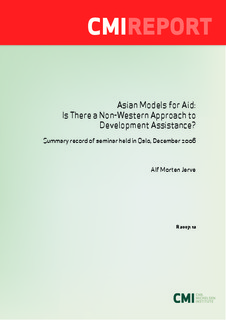| dc.description.abstract | The expansion of the international donor community clearly challenges the current “consensus” of a new “harmonised” aid architecture, and calls for strategies on how to adjust to an aid landscape with greater plurality and variety, for recipients and donors alike. A first step for a donor like Norway is to ask what can be learned from the Asian donors on new or alternative forms of donorship. What can we learn from Japan’s extensive aid experience, but also from China and India which started south-south cooperation and aid programmes back in the early 1950s? Do they represent alternative thinking on what brings economic development and poverty reduction? Will this challenge some of the basic ideas underpinning the current emphasis of national poverty reduction strategies supported by the donor community? Such questions formed the background for a seminar arranged in Oslo, 5 December, 2006, with experts on Japan, China, India and South Korea. This report is a summary of the main messages and arguments. | |
